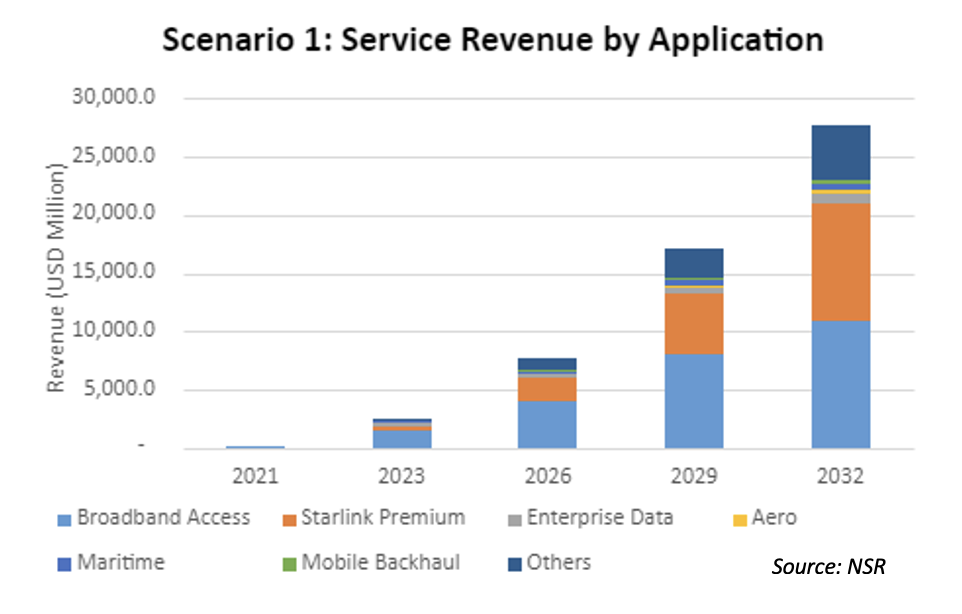Starlink’s Mobility Play: The road to profitability?
Taking a page from SES’ O3b in serving the Other 3 billion to tapping high-value cruise markets, Starlink is addressing mobility markets with a slew of recent deals. The latest is Florida-based Brightline, which announced in May 2023 that it is offering free Starlink connectivity to passengers. As reported by Satellite Today, this is Starlink’s first customer in the railroad and passenger rail industry following new customers in the aviation and cruise industries, including Norwegian Cruise Line, Carnival Corporation, and Royal Caribbean Group and Hawaiian Airlines. It is worth noting that Lithuania Railways is trialing Starlink and Ukraine’s Ukrzaliznytsia has completed trials as well. Will Starlink experience the same success as O3b has, and more importantly, will mobility become the cornerstone of Starlink’s profitability strategy?
The market opportunity that mobility provides is indeed enticing. With business travel and tourism back with a vengeance, mobility in all platforms, shapes and forms is leading to mobility as possibly becoming the anchor market for growth. It should be noted and recalled that in 2019, the year before the pandemic took place, Delta Airlines’ free WiFi proposition led to the prospect of a supply crunch as the free model will likely be replicated by other airlines around the globe. And now that Delta is offering free WiFi service to domestic flights in the US via its partnership with T-Mobile and Viasat with full availability on international and regional aircraft by end-2024, it does appear that mobility will be a growth market to be pursued by all players, including GEOs, MEOs and LEOs.
To be clear, Starlink is not pivoting from serving the underserved to tapping high-value mobility markets. SpaceX has announced that Starlink has reached 1.5 million subscribers — after hitting 1 million at the end of 2022. As such, the strategy is not a pivot but a widening of vertical targets where Starlink will go after everything – digital divide, enterprise, mobility, government/military and even IoT with its purchase of Swarm Technologies.

So is mobility the road to profitability for Starlink? NSR ran a few scenarios to look into Starlink’s viability and forecasted revenue capture per application. As the graph depicts, mobility comprising of Aero, Maritime and Land (clumped in the “Others” category) will be one of the roads to be taken by Starlink but it is not the only road to anchor growth. In fact, Broadband Access and Starlink Premium will be the key offerings. With heavy CAPEX expenditures in a cycle of 5-7 years for constellation replenishments, coupled with subsidies on ground equipment, every opportunity will be targeted by Starlink to fill its fleet. Satellites are often regarded as “melting ice cubes” and it is imperative that resources be used and monetized before their demise.
The Bottom Line
In NSR’s view, Starlink’s strategy of targeting all mobility verticals as well as offering services to other market segments is a prudent move. It is also targeting nascent and still to be defined offerings such as satellite direct-to-cell (D2C) services where technical, market and regulatory issues are still to be resolved. The other or counter strategy to the “target everything approach” is to carve a niche such as restricting service provisioning only to high-end clients particularly enterprise customers where one can extract premium pricing. Which will be the winning strategy remains to be seen and the marketplace will determine that over time. In the end, however, satellites provide a pipe whether smart or dumb pipes, and whatever service(s) or vertical(s) run through the pipe the most will likely win, especially as the supply of capacity in LEO will be massive. Targeting multiple verticals also provides a hedge and mitigates risk. This is one of the lessons of the pandemic where highly lucrative aero/IFC services as well as maritime/cruise ship services disappeared virtually overnight. As such, having a wide base of customers is a sound risk mitigation strategy.
